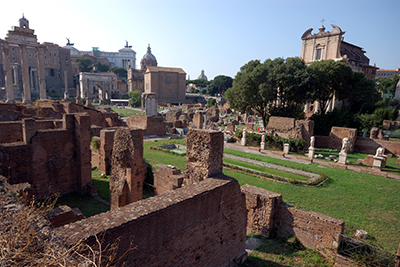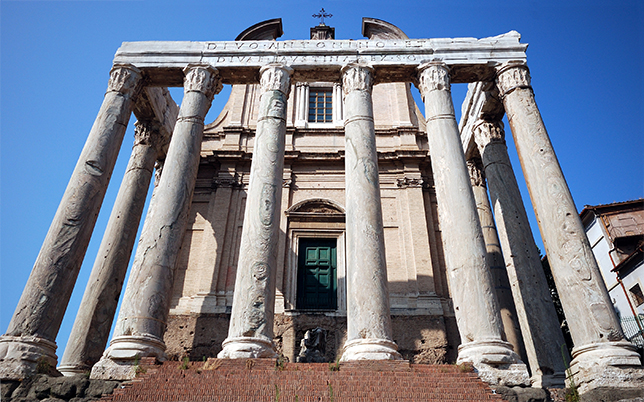
As one of the birthplaces of Western civilization, the Eternal City has more than its fair share of history lessons to offer. Of course, we all know the major attractions from our textbooks; but getting to see the Roman Forum and Colosseum up close and personal is a whole different story. Despite recent architecture and, obviously, today’s infrastructures, an average stroll in Rome shows you archaeological sites around every corner and has the power to make you feel like an extra in Ben-Hur. However, there are some places where you can experience ancient Rome as if it were not so ancient after all — almost as if you could still hear toga-clad senators wishing luck to sandaled gladiators on their way to the infamous matches.
If you are serious about capturing the spirit of Rome’s glory days, start your visit where it all began, at the Roman Forum, the first pulsing heart of the future capital of an empire that eventually sprawled from France to Syria. You can access the archaeological site through different entrances, from Via di San Gregorio to start the tour from the Palatine Hill or Via della Salaria Vecchia to kick off your visit from the Forum. Either way, as soon as you step over the modern threshold, you will be whirled back a couple thousand years so quickly that it will take you a moment to realize you are actually walking on the same ground as Cicero, Nero and Caligula once did.
Even though more than 2,000 years old and for centuries abandoned after Rome’s decline, today you can still admire the imposing temples and where shops (tabernae) and royal houses were, including the mansion where allegedly Emperor Augustus was born. Rather impressive, and by all means worth a stop, is the altar where Julius Caesar was cremated, and where people still bring fresh flowers as a sign of respect and literally never-ending gratitude.
Be sure to hit the Colosseum as well because the same ticket you bought for the Forum and the Palatine is also valid also at the Colosseum. It costs €12 ($16) and can be used over the span of two days. Tickets can be bought at both the Roman Forum and the Colosseum.
Colosseum
While today it might not sound like daily routine, back in those days, leisure time was taken pretty seriously — to the extent that many (such as the gladiators) chose to die for it. And that’s where the Colosseum comes in. Though you may think everyone knows the history behind the Colosseum, a visit to what is possibly Rome’s most photographed landmark will inevitably show you a crucial aspect of the city’s ancient habits.
Walking through and pausing on its bleachers will make you a late spectator of what was considered the highest peak of entertainment at the time. The benefit of being an onlooker in the 21st century is that you can picture the wild games from any point of view — feeling privileged in the front row (formerly allocated to emperors, senators and religious authorities), one level up where patricians sat and finally on the higher stands meant for the cheering plebeians. With a guide, you can admire the Colosseum also from a gladiator’s perspective, onstage and in the tunnels from which animals were lifted up and potential heroes awaited their fate.
Baths of Caracalla
Public shows were not the only leisure activity, and visiting the impressive Baths of Caracalla will prove as revealing as cruising inside the iconic Colosseum. Precious evidence of Romans’ eye for detail and incredible hydraulic expertise, the baths near the Circus Maximus had a capacity of more than 6,000 bathers per day and were heated with some 50 ovens.
For as much luxury as today’s spas can boast, a visit to the Baths of Caracalla will inevitably belittle all your previous experiences — though you’ll have to use your imagination. The experience started in the gym (yes, even the Romans worked out). Once the blood was pumping, they’d move to the caldarium (a room warmed with a device of under-floor hot air), before transferring to the tepidarium, (a transition hall where the body started cooling down) and finally to the frigidarium (the coolest room, beautifully covered with a three-cross vault). The underground basement, recently opened to the public, was comprised of large tunnels, stockrooms, the heating system and the water pipes. A large pool, two libraries and a garden completed the experience, and present visitors can’t avoid staring in awe (and slightly envying the ancient residents).
Case Romane del Celio
If you are bent on feeling cozy with patricians, devote a Friday evening to an original Roman aperitivo. This happens at Case Romane del Celio, near the Circus Maximus, on Clivo di Scauro (an ancient Roman road connecting the Palatine and Caelian hills). Here, just beside the Basilica of Saints John and Paul is a small door leading to former tabernae (shops), insulae (workers’ dwellings) and a domus (patrician house). Passing through the shops and workers’ modest houses, visitors will have the chance to peek at ancient private space and admire frescoes, decorations, typical architecture of the late imperial age and relics of past lives. As a perfect reward, the tour ends tickling your senses with a Roman aperitif based on mulsum, drink made with wine and honey, and delicacies with barley, chickpeas, omelet, toasted bread with olive paste and cakes prepared according to the recipes that poets of the likes of Cato and Virgil left to posterity to enjoy.
The tour at Case Romane del Celio takes place every Friday at 7:30 p.m., costs €16 ($22) and includes a visit to the archaeological sites and the aperitif. Booking is mandatory and can be done through the official website Spazio Libero Coop.
Photos Courtesy of Angela Corrias


